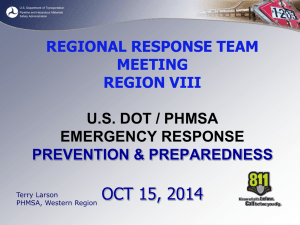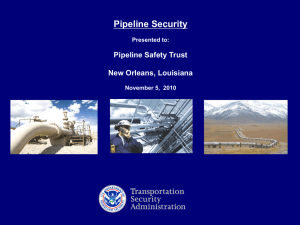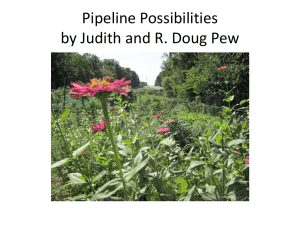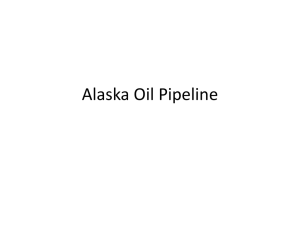here - Regional Response Team Northwest Area Committee
advertisement
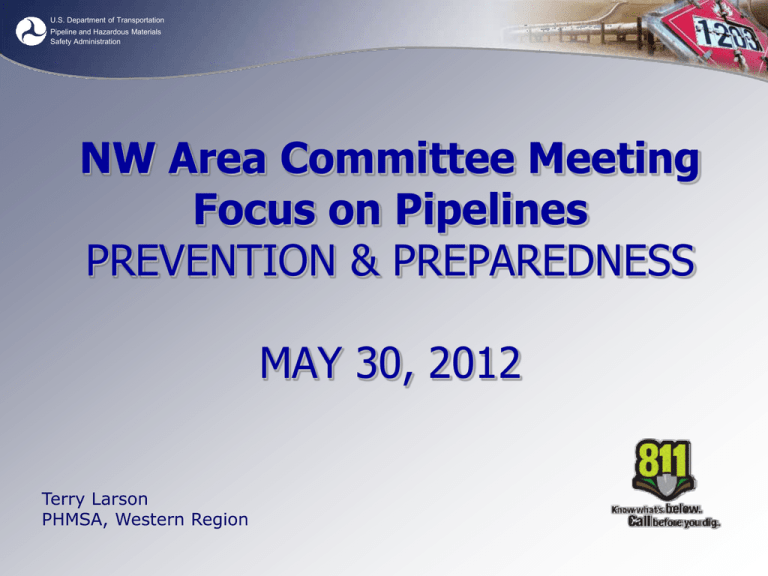
U.S. Department of Transportation Pipeline and Hazardous Materials Safety Administration NW Area Committee Meeting Focus on Pipelines PREVENTION & PREPAREDNESS MAY 30, 2012 Terry Larson PHMSA, Western Region U.S. Department of Transportation Pipeline and Hazardous Materials Safety Administration Mission: To ensure the safe, reliable, and environmentally sound operation of the Nation’s pipeline transportation system. U.S. Department of Transportation Pipeline and Hazardous Materials Safety Administration PHMSA Regions/Offices Eastern Region Western Region Central Region Trenton Lakewood Kansas City T&Q Oklahoma City HQ Washington, D.C. Atlanta Southern Region Southwest Region Houston U.S. Department of Transportation Pipeline and Hazardous Materials Safety Administration Pipeline Safety Regulations The rules governing pipeline safety are included in Title 49 of the Code of Federal Regulations (CFR), Parts 190-199. Individual states may have additional or more stringent pipeline safety regulations. 49 CFR Parts 190-199 • Part 190 - procedures used by OPS to carry out regulatory duties. • Part 191 - requirements on operators of gas pipelines • Part 192 - requirements for gas pipelines. These regulations contain sections applicable to gas gathering, transmission, and distribution lines. • Part 193 - safety standards for liquefied natural gas (LNG) facilities. • Part 194 - requirements for oil spill response plans. • Part 195 - safety standards and reporting requirements for oil and carbon dioxide pipelines. • Parts 196-197 are currently reserved for future use. • Part 198 – establishes grants for State pipeline safety programs. • Part 199 – drug and alcohol programs U.S. Department of Transportation Pipeline and Hazardous Materials Safety Administration PREVENTION U.S. Department of Transportation Pipeline and Hazardous Materials Safety Administration Part 195- Design and Construction • Design Criteria • Trenching • Welding • Non destructive testing • Coating • Lowering and backfilling • Depth of Cover • Hydro-testing • Valve location U.S. Department of Transportation Pipeline and Hazardous Materials Safety Administration Part 195 Operation and Maintenance • Procedures Manual for Operations, Maintenance & Emergencies – Establish and maintain liaison with responder orgs – Abnormal Operations – Emergencies • Response • Equipment • Actions • Minimize public exposure • Training U.S. Department of Transportation Pipeline and Hazardous Materials Safety Administration PART 195 Integrity Management Programs (IMP) • Assessment of pipeline integrity in high consequence areas (HCA) • Integration of risk and knowledge • Allocate resources to focus on the highest risks • Operators developing their own performance measures and performance monitoring programs • Written integrity programs are a living document to drive continuous improvement U.S. Department of Transportation Pipeline and Hazardous Materials Safety Administration PART 195 - Operator Qualification • Pipeline Employees and Contractors must be Qualified to perform Covered Tasks • Personnel must be Trained and Evaluated to ensure: • Safe and Proper Performance of Covered Task • Recognize and React to Abnormal Operating Conditions • Consensus Standard - ASME Standard B31Q U.S. Department of Transportation Pipeline and Hazardous Materials Safety Administration PART 195 Public Awareness Programs • In June 2005, regulations revised to require all operators to comply with API Recommended Practice 1162 • Communications Plans tailored to Stakeholder Audience – Residents along ROW, General Public, Local Public Officials, Emergency Responders • Operators must evaluate effectiveness of public awareness programs U.S. Department of Transportation Pipeline and Hazardous Materials Safety Administration PART 195 Additional Requirements • Damage Prevention • CPM Leak Detection • Control Room Management • Corrosion Control U.S. Department of Transportation Pipeline and Hazardous Materials Safety Administration PREPAREDNESS U.S. Department of Transportation Pipeline and Hazardous Materials Safety Administration Part 194 – Response Plans • Operators required to submit Response Plans – Some exceptions – State Programs • Substantial Harm or Significant and Substantial Harm to environment by discharge of oil to navigable waters or shorelines • Worst Case Discharge • Certify that response plan is consistent with NCP and ACP U.S. Department of Transportation Pipeline and Hazardous Materials Safety Administration PART 194 – Appendix A Guidelines for Preparation of Response Plans • Section 1. Information Summary for Core Plan – Name and address of the operator – Qualified Individual ID – Response Zone ID – Certification of Significant and Substantial Harm – Type of oil and volume of Worst Case Discharge – Certification the operator has personnel, equipment, and means (internal or by contract) to respond to Worst Case Discharge U.S. Department of Transportation Pipeline and Hazardous Materials Safety Administration PART 194 – Appendix A (cont.) • Section 2. Notification Procedures – Notifications to federal, state and local officials – Notifications to Qualified Individuals – Internal Notification Call Down Tree U.S. Department of Transportation Pipeline and Hazardous Materials Safety Administration PART 194 – Appendix A (cont.) • Section 3. Spill Detection and On-Scene Spill Mitigation Procedures – Methods of Initial Discharge Detection: • Procedures by priority • Equipment List • External response equipment information • Personnel contact information U.S. Department of Transportation Pipeline and Hazardous Materials Safety Administration PART 194 – Appendix A (cont.) • Section 4. Response Activities – Operating personnel response responsibilities and actions i.e. first responder – Qualified Individual Responsibilities – Procedures for coordinating with OSC – Oil Spill Contractor information • Available under contract or other approved means • Equipment and supplies • Personnel and response time U.S. Department of Transportation Pipeline and Hazardous Materials Safety Administration PART 194 – Appendix A (cont.) • Section 5. List of Contacts – 24 Hour Contact information for: • Operator response personnel • Qualified Individuals • Insurance, lawyers, etc. • Persons or organizations for activation or response U.S. Department of Transportation Pipeline and Hazardous Materials Safety Administration PART 194 – Appendix A (cont.) • Section 6. Training Procedures – Description of Training procedures and Programs of the operator i.e. knowledge of: • Assignment in Incident Command Structure • Product characteristics • Response actions including priority • Other emergencies – fire, security, etc. – Evaluate performance annually not to exceed 15 months for supervisors and personnel U.S. Department of Transportation Pipeline and Hazardous Materials Safety Administration PART 194 – Appendix A (cont.) • Section 7. Drill Procedures – Drill Program and Procedures (FOLLOW PREP) • Announced and unannounced drills: – Quarterly Notification and Action Drills for both manned and unmanned facilities – QI, Key OPS Personnel – Annual table top drills – Annual equipment deployment drills – Every 3 years conduct a drill that exercises entire response plan. U.S. Department of Transportation Pipeline and Hazardous Materials Safety Administration PART 194 – Appendix A (cont.) • Section 8. Response Plan Review and Update Procedures – If substantial new condition or information submit change within 30 days i.e. change in: • Worst Case Scenario • OSRO/QI • Response Procedures • Significant change in NCP or ACP – Review, update and resubmit Response Plan every 5 years – Evaluate response plans effectiveness after a release U.S. Department of Transportation Pipeline and Hazardous Materials Safety Administration PART 194 – Appendix A (cont.) • Section 9. Response Zone Appendices – Provide information on: • Zone worst case discharge • Operator personnel information • Response equipment and supplies • Response contractors • Potentially affected environmentally sensitive areas • Piping diagrams and alignment sheets • Product transported U.S. Department of Transportation Pipeline and Hazardous Materials Safety Administration Questions - 24 -



